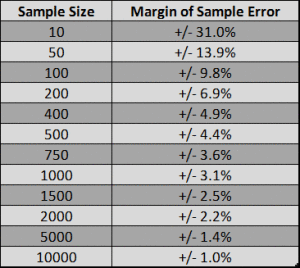Sample Size It
When it comes to survey’s one of the most common questions is “How many completed survey’s do we need?” The most important factor to consider is the margin of error that you are comfortable with. Before we get to that, let’s address a big misconceptions about sample sizes.
Population Size
The first misconception is that the population size determines the sample size. This is not true. The population size has no influence on what sample size you need. One example I’ve read is a sample of 500 is just as accurate from the population of China (1.3 billion) as it is Boston (625,000 people). The important aspect of this is that the sample of 500 is random. If you were conducting a survey on gun control and you r sample of 500 came from members of the NRA, that wouldn’t be a random sample.
Margin of Error
How much inaccuracy are you willing to accept in your sample? You often hear during election season TV networks declaring a winner, saying something to the effect “Smith is the winner with 60% of the votes, with a +/- 3% margin of error”. What the means is that, according to their analysis, Smith will be the winner with 57% – 63% of the vote. To get a 3% margin of error you need a sample of approximately 1,100 people out of the population of total registered voters for the district.
Other areas require tighter margins of error. For example, medical research often requires a much smaller margin of error. If your business is looking to make a substantial investment they will often require a +/- margin of error of 1%. However, social sciences and some marketing research have larger ranges.
 The table shows sample size and the margin of error for that sample size. This helpful when you are considering the cost of acquiring a sample. There are survey companies that charge a fee for completed survey’s. If the cost per completed survey is $10 and you initially think that you need a margin of error of +/- 1.5%, you will need 5,000 surveys at a cost of $50,000. You could increase your margin of error to 2.2% and need 2,000 completed survey’s at a cost of $20,000. Now the researcher can ask if the additional .8% on the margin of error is worth the additional $30,000 investment.
The table shows sample size and the margin of error for that sample size. This helpful when you are considering the cost of acquiring a sample. There are survey companies that charge a fee for completed survey’s. If the cost per completed survey is $10 and you initially think that you need a margin of error of +/- 1.5%, you will need 5,000 surveys at a cost of $50,000. You could increase your margin of error to 2.2% and need 2,000 completed survey’s at a cost of $20,000. Now the researcher can ask if the additional .8% on the margin of error is worth the additional $30,000 investment.
Sample Size
When looking for an accurate sample size, determine the appropriate margin of error for your project and then use that to find your sample size. Once you have your sample size be sure that the samples you collect are random.

